標題
- 2014春天讀詩節——詩情畫意讀臺灣系列
- 【演講】Matthew S. Erie:Embodiments of Law: Women, Patriarchy, and Family Law in Muslim China
- 【演講】Wendy Swartz:The Intertextual Brush: Philosophy in Early Medieval Chinese Poetry
- 【演講】Jessica Chen Weiss:Powerful Patriots: China's Management Of Anti-Japanese Protest, 1985-2012
- 【演講】Scott L Kastner:A Relationship Transformed: Rethinking the Prospects for Conflict and Peace in the Taiwan Strait
- 【演講】何明修:族群、黨國與臺灣工人階級的形成:以戰後初期的糖廠與煉油廠為例
- 【演講】Susan Whitfield:Transmissions of Buddhist Architecture in the Tarim Basin and China
- 【演講】黃秀政:1895年臺灣割讓與臺灣命運的轉折
- 【演講】林美容:魔神仔的人類學想像
- 【演講】侯坤宏:當代最具創見的佛教思想家:印順法師
- 【演講】雷祥麟:Neither Donkey nor Horse: Medicine and the Struggle over China's Modernity
- 【演講】葛兆光:「中國」的認同困境——從近世歷史看「中國」
- 【演講】黃智慧:困境與僵局中的行動地圖——2013年臺灣原住民族重大事件評析
- 【演講】葛兆光:納四裔入中華——1920至1930年代中國歷史、考古與人類學界對「中國」與「中華民族」的論證
- 【演講】林益仁:原住民族遷移與生態政治:以泰雅族傳統領域的概念化為例
- 【演講】Mark Gamsa:Refractions of China in Russia and Russia in China: Translation and Material Culture
- 【演講】餘淑釩:「Masamu」:當代Bunun的婚姻困境──以東臺灣palalavi氏族為例
- 【演講】Yingjin Zhang:Witness outside History: Play for Alteration in Modern Chinese Culture
- 【演講】Li Zhang:The Rise of Therapeutic Governing in Postsocialist China
- 【演講會】清代経済史の諸問題
- 【演講會】臺灣、沖縄、…分斷と孤立のアジアをつなぎ直す
- 【工作坊】2014年第一次環境史工作坊
- 【系列演講】「歌謠、小說與城市」系列演講
- 【系列演講】國立臺灣文學館2014年上半年「府城講壇」
- 【展覽】「歷史與文學」特展
- 【展覽】「鑿破鴻蒙」紀念特展
- 【展覽】永是有情人——琦君捐贈展
- 【展覽】海上瓷路——粵港澳文物大展
- 【展覽】「臺灣農夫‧穿越時空的農業記錄」館藏特展
- 【展覽】履踪:臺灣原住民文獻圖畫特展
- 【展覽】定州花瓷--院藏定窯系白瓷特展
- 【展覽】光照大千──絲綢之路的佛教藝術考古特展
- 【展覽】水火交‧天人會:臺灣王爺信仰特展
- 【展覽】明四大家特展——沈周
- 【展覽】高句麗壁畫古墳寫真展
- 【展覽】Colors of the Universe: Chinese Hardstone Carvings
- 【展覽】Ink Art: Past as Present in Contemporary China
2014春天讀詩節——詩情畫意讀臺灣系列
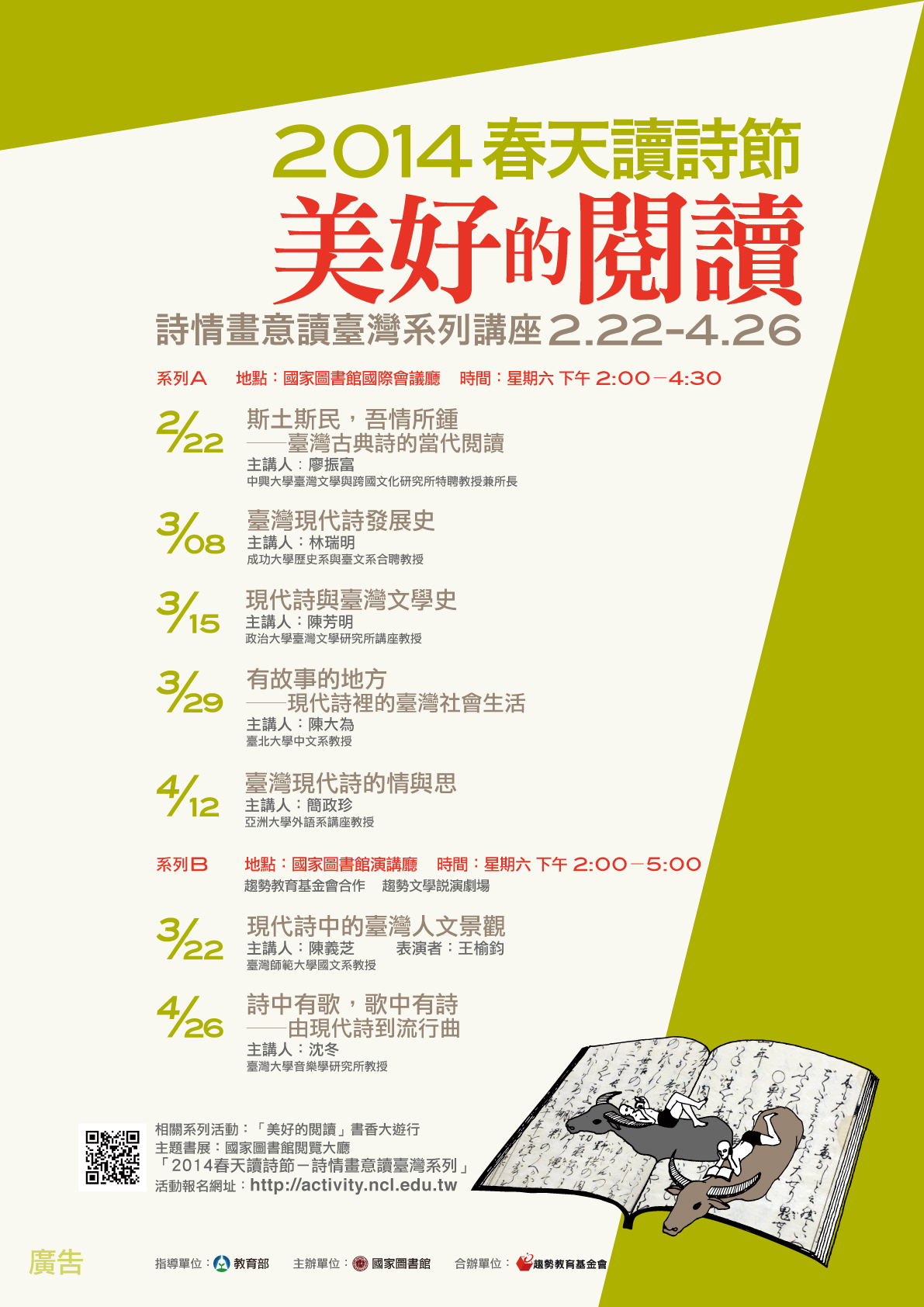
標題:
2014春天讀詩節——詩情畫意讀臺灣系列
時間:
2014年2月至4月,共7場
地點:
國家圖書館(臺北市中正區中山南路20號)
主辦單位:
國家圖書館、趨勢教育基金會
聯絡人:
歐陽芬,02-2361-9132#722
內容簡介:
春天代表黎明及誕生,在歡欣歌詠之際,由國家圖書館主辦之「2014春天讀詩節」講座活動將於2月22日(星期六)下午起開講。本年度規劃以「詩情畫意讀臺灣」為系列演講的主軸。2月22日下午首先邀請:廖振富(中興大學臺灣文學與跨國文化研究所特聘教授兼所長)主講「斯土斯民,吾情所鍾──臺灣古典詩的當代閱讀」,為2014春天讀詩節揭開序幕。歡迎大家以悠悠詩心閱讀臺灣各種面貌。
各專題演講辦理時間、主講人及講題資訊:
【系列A】
►地點:國家圖書館國際會議廳
►時間:14:00-16:30
2月22日
斯土斯民,吾情所鍾──臺灣古典詩的當代閱讀(廖振富,中興大學臺灣文學與跨國文化研究所特聘教授兼所長)
3月8日
臺灣現代詩發展史(林瑞明,成功大學歷史系與臺文系合聘教授)
3月15日
現代詩與臺灣文學史(陳芳明,政治大學臺灣文學研究所講座教授)
3月29日
有故事的地方──現代詩裡的臺灣社會生活(陳大為,臺北大學中文系教授)
4月12日
臺灣現代詩的情與思(簡政珍,亞洲大學外語系教授)
【系列B】
►地點:國家圖書館演講廳
►時間:14:00-17:00
3月22日
現代詩中的臺灣人文景觀(陳義芝,臺灣師範大學國文系教授)
4月26日
詩中有歌,歌中有詩──由現代詩到流行曲(沈冬,臺灣大學音樂研究所教授)
有意參加者,請逕行線上報名:http://activity.ncl.edu.tw
系統號:
A-002834
【演講】Matthew S. Erie:Embodiments of Law: Women, Patriarchy, and Family Law in Muslim China
標題:
【演講】Matthew S. Erie:Embodiments of Law: Women, Patriarchy, and Family Law in Muslim China
時間:
2014年2月3日(週一)12:00
地點:
Princeton University, Jones Hall, Room 202(202 Jones Hall,Princeton, NJ 08544,USA)
主辦單位:
East Asian Studies Program, The Department and Program in Near Eastern Studies
主講人:
Matthew S. Erie (Postdoctoral Research Associate, PIIRS)
系統號:
A-002698
【演講】Wendy Swartz:The Intertextual Brush: Philosophy in Early Medieval Chinese Poetry
標題:
【演講】Wendy Swartz:The Intertextual Brush: Philosophy in Early Medieval Chinese Poetry
時間:
2014年2月4日(週二)12:00-13:00
地點:
University of Michigan School of Social Work(1080 S. University Avenue Ann Arbor, MI 48109-1106)
主辦單位:
Center for Chinese Studies, University of Michigan
主講人:
Prof. Wendy Swartz (Rutgers University)
內容簡介:
A meaningful study of intertextuality must involve examining how a text functions as part of a network of textual relations, and is thus not reducible to influence studies, or a mere tracing of sources. It has special significance and ramifications for early medieval Chinese literary history in light of the fluid boundaries of textual traditions and the dynamic interactions among diverse, expanding repertoires of literary and cultural meanings. It is within this context of a growing body of literary sources and an interconnectedness of not only different intellectual repertoires (e.g. Confucian, Lao-Zhuang, and Buddhist) but also different branches of learning (e.g. philosophy, poetry) that my lecture will examine how writers best made use of diverse, heterogeneous sources suited to their needs.
About the Speaker
Wendy Swartz is Associate Professor of Chinese Literature at Rutgers University. She has also taught at Columbia University and the University of California, Santa Barbara. Her research is primarily on early medieval Chinese poetry, poetics, and literary criticism. She is the author of Reading Tao Yuanming: Shifting Paradigms of Historical Reception (427-1900) (Harvard University Asia Center, 2008), the principal editor of Early Medieval China: A Sourcebook (Columbia University Press, 2014), and has published numerous articles on early medieval literature in leading American journals.
系統號:
A-002683
【演講】Jessica Chen Weiss:Powerful Patriots: China's Management Of Anti-Japanese Protest, 1985-2012
標題:
【演講】Jessica Chen Weiss:Powerful Patriots: China's Management Of Anti-Japanese Protest, 1985-2012
時間:
2014年2月6日(週四)12:00-13:15
地點:
Stanford University, Philippines Conference Room, Encina Hall, 3rd Floor(Encina Hall, 616 Serra St, Stanford, CA 94305)
主辦單位:
Center for East Asian Studies, Stanford University
主講人:
Jessica Chen Weiss (Assistant Professor of Political Science, Yale University)
內容簡介:
China and Japan have entered a dangerous standoff in the East China Sea. As China launched a series of unprecedented maritime patrols, anti-Japan protests erupted in more than 200 Chinese cities to condemn Japan's nationalization of the Senkaku/Diaoyu islands. What missed signals and domestic political pressures led to this crisis?
Why did Chinese authorities tolerate widespread anti-Japanese protests in 2012 after restraining protests in earlier crises, including the 2010 dispute over a Chinese fishing captain's arrest? Drawing on material from her forthcoming book, Powerful Patriots: Nationalist Protest in China's Foreign Relations (Oxford University Press, Summer 2014), Professor Jessica Chen Weiss will trace China's management of anti-Japan protest from 1985 to 2012, discussing the role of nationalism and public opinion in Chinese foreign policy.
系統號:
A-002644
【演講】Scott L Kastner:A Relationship Transformed: Rethinking the Prospects for Conflict and Peace in the Taiwan Strait
標題:
【演講】Scott L Kastner:A Relationship Transformed: Rethinking the Prospects for Conflict and Peace in the Taiwan Strait
時間:
2014年2月7日(週五)12:00-13:15
地點:
Stanford University, Oksenberg Conference Room, Encina Hall, 3rd Floor(Encina Hall, 616 Serra St, Stanford, CA 94305)
主辦單位:
Democracy in Taiwan Project & Center on Democracy, Development and the Rule of Law (CDDRL)
主講人:
Scott L Kastner (Associate Professor and Director of Undergraduate Studies, University of Maryland)
聯絡人:
E-mail: alice.carter@stanford.edu
內容簡介:
After long being viewed as potential flashpoint, relations across the Taiwan Strait have stabilized tremendously in recent years, reflecting moderation in the approaches both Beijing and Taipei have taken with regard to the cross-Strait sovereignty dispute. In my presentation, I consider whether this new-found stability in the Taiwan Strait is likely to persist. In particular, I consider how fundamental trends in cross-Strait relations—such as rapidly growing Chinese military power and deepening cross-Strait economic exchange—are affecting the likelihood that the conflict scenarios which worried analysts prior to the current détente will re-emerge as future concerns. My analysis suggests that the relationship across the Taiwan Strait is likely to be more stable in the years ahead than was the case in the years preceding 2008; this conclusion holds even if there is a change in ruling party in Taiwan. But I also emphasize that the cross-Strait relationship has not been fundamentally transformed, and that the potential for serious conflict remains.
系統號:
A-002712
【演講】何明修:族群、黨國與臺灣工人階級的形成:以戰後初期的糖廠與煉油廠為例
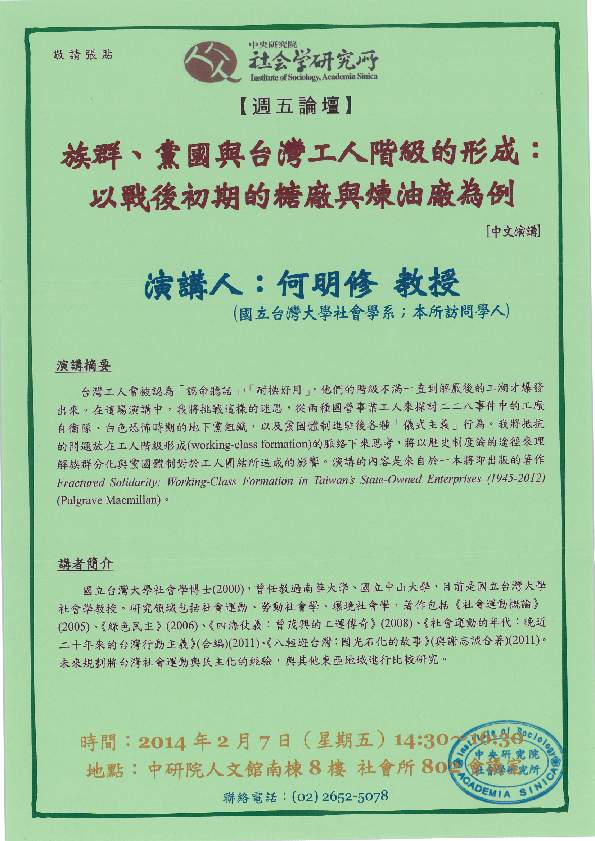
標題:
【演講】何明修:族群、黨國與臺灣工人階級的形成:以戰後初期的糖廠與煉油廠為例
時間:
2014年2月7日(週五)14:30-16:30
地點:
中央研究院人文館南棟社會所802會議室(臺北市南港區研究院路二段128號)
主辦單位:
中央研究院社會所
主講人:
何明修(國立臺灣大學社會學系教授)
內容簡介:
演講摘要
臺灣工人常被認為「認命聽話」,「耐操好用」,他們的階級不滿一直到解嚴後的工潮才爆發出來。在這場演講中,我將挑戰這樣的迷思,從兩種國營事業工人來探討二二八事件中的工廠自衛隊、白色恐怖時期的地下黨組織,以及黨國體制進駐後各種「儀式主義」行為。我將抵抗的問題放在工人階級形成(working-class formation)的脈絡下來思考,將以歷史制度論的途徑來理解族群分化與黨國體制對於工人團結所造成的影響。演講的內容是來自於一本將即出版的著作Fractured Solidarity: Working-Class Formation in Taiwan’s State-Owned Enterprises (1945-2012) (Palgrave Macmillan)。
講者簡介
國立臺灣大學社會學博士(2000),曾任教過南華大學、國立中山大學,目前是國立臺灣大學社會學教授。研究領域包括社會運動、勞動社會學、環境社會學,著作包括《社會運動概論》(2005)、《綠色民主》(2006)、《四海仗義:曾茂興的工運傳奇》(2008)、《社會運動的年代:晚近二十年來的臺灣行動主義》(合編)(2011)、《八輕遊臺灣:國光石化的故事》(與謝志誠合著)(2011)。未來規劃將臺灣社會運動與民主化的經驗,與其他東亞地域進行比較研究。
系統號:
A-002657
【演講】Susan Whitfield:Transmissions of Buddhist Architecture in the Tarim Basin and China
標題:
【演講】Susan Whitfield:Transmissions of Buddhist Architecture in the Tarim Basin and China
時間:
2014年2月7日(週四)16:00-17:30
地點:
Levinthal Hall, Stanford Humanities Center, Stanford University(424 Santa Teresa St, Stanford, CA 94305,USA)
主辦單位:
Ho Center for Buddhist Studies at Stanford & The Silkroad Foundation & Stanford Humanities Center
主講人:
Susan Whitfield (British Library)
內容簡介:
During the end of the first millennium B.C. Buddhism began to spread into Central Asia. Travelling along older land and sea trade routes that were newly secured under the Kushan Empire, it encountered a time of great political, economic and cultural efflorescence, as these routes—today collectively known as the ‘Silk Roads’—brought cultures into contact and acted as a catalyst for the development of new forms. This was the case for all manifestations of Buddhism, not least its architecture.
This lecture will explore the archaeology and art of the stupa, looking at the complexities of tracing its development as the form travelled from India along the land routes across Central Asia and into China.
系統號:
A-002713
【演講】黃秀政:1895年臺灣割讓與臺灣命運的轉折
標題:
【演講】黃秀政:1895年臺灣割讓與臺灣命運的轉折
時間:
2014年2月8日(週六)10:00-12:00
地點:
國立臺灣圖書館4樓4045教室(新北市中和區中安街85號)
主辦單位:
國立臺灣圖書館參考特藏組
主講人:
黃秀政(臺北市文獻委員會《續修臺北市志》總纂)
聯絡人:
陳先生,Tel: 02-2926-6888#4221
內容簡介:
【臺灣學系列講座(90)】
有意參加本演講者可逕至官網線上報名,或演講當日現場報名。
註:凡使用線上報名系統者,視為已同意本館公開使用報名者之「姓名資訊」;倘若報名者不願公開「姓名資訊」於本館網站中,則請勿使用線上報名系統,並請於講座舉行當日現場報名,謝謝。
系統號:
A-002635
【演講】林美容:魔神仔的人類學想像
標題:
【演講】林美容:魔神仔的人類學想像
時間:
2014年2月12日(週三)12:00-13:30
地點:
中央研究院民族所第一會議室(臺北市南港區研究院路二段128號)
主辦單位:
中央研究院民族學研究所
主講人:
林美容(慈濟大學宗教與人文研究所教授)
聯絡人:
林音秀,E-mail: world66@gate.sinica.edu.tw
內容簡介:
講綱:
魔神仔的傳說在臺灣民間流傳廣泛且長久,幾乎臺灣各個主要的族群都有類似的傳說。這些傳說不但與臺灣民間信仰、文化脈絡有關,也與動物、植物、氣候等自然界事物密切關聯。近年來我在臺灣和福建地區蒐集將近400則魔神仔相關的傳說故事。我提出一個假說:魔神仔傳說故事很可能是從人類的集體無意識所逬發出來的產物。我以此來說明魔神仔傳說故事中一再重複出現的母題(motif),例如人類從生食(魔神仔會給人塞草螟仔腳、牛屎)到熟食,從穴居(魔神仔會給人帶到石壁硜)到有屋可居,人類從無名到有名(被魔神仔迷走,要大聲叫那人的名字)等,凡此種種皆是人類在文明演化過程中巨大而重要的轉折。魔神仔的傳說故事,不僅具有比較民俗學的研究價值,也提供了人類學如何透過口說材料去勾連早期人類的一個理解的途徑。
注意事項:
1. 報名網頁:http://www.ioe.sinica.edu.tw/ (一律從「民族所網頁」報名)
2. 報名期間:即日起至 1/26(週日)23:00為止。
3. 錄取與否通知:於 1/28(週二)統一回覆錄取與否通知。
4. 錄取名額:錄取名額為50名,並保留錄取與否的權利。
5. 演講於當日12:00開始,會場於12:15前提供餐點。
6. 請自備環保餐具。
7. 如若報名兩次不出席且沒有事先告知者,將取消報名資格。
8. 請留意是否收到報名回覆信函,並確認是否錄取,謝謝。
9. 聯絡資訊:林音秀 小姐 E-mail: world66@gate.sinica.edu.tw
系統號:
A-002668
【演講】侯坤宏:當代最具創見的佛教思想家:印順法師

標題:
【演講】侯坤宏:當代最具創見的佛教思想家:印順法師
時間:
2014年2月14日(週五)14:00-16:00
地點:
國史館4樓大禮堂(臺北市中正區長沙街1段2號)
主辦單位:
國史館
主講人:
侯坤宏(國史館纂修兼修纂處處長)
聯絡人:
國史館采集處推廣科,Tel: 02-2316-1055
內容簡介:
【人物系列專題演講(十二)】
印順法師(1906-2005)是近代漢傳佛教最具影響力的思想家,有「玄奘以來第一人」之譽。佛法源自印度,流布各方,其間因時空變異,頗有變質、失真之處。法師特別著重於印度與中國佛教思想,自1930年出家後,即獻身鑽研佛教教理、教史與教制,1949年以前就出版了多部具有相當份量的著作;輾轉來臺後,又完成多部更具學術功力的專著,並即身完成《妙雲集》、《華雨集》等編印工作;就學術史觀點衡量其佛教思想,頗具「典範」意義,值得關注。
※教師及公務人員全程參與者,可核發研習時數2小時
※活動結束後,可獲得「國史館文化饗宴」集點貼紙1張
系統號:
A-002699
【演講】雷祥麟:Neither Donkey nor Horse: Medicine and the Struggle over China's Modernity

標題:
【演講】雷祥麟:Neither Donkey nor Horse: Medicine and the Struggle over China's Modernity
時間:
2014年2月18日(週二)16:30
地點:
Princeton University, Jones Hall, Room 202(202 Jones Hall,Princeton, NJ 08544,USA)
主辦單位:
East Asian Studies Program
主講人:
Sean Hsiang-lin Lei(雷祥麟,中央研究院近史所副研究員)
內容簡介:
This talk aims to answer one question: How was Chinese medicine transformed from an antithesis of modernity in the early twentieth century into a potent symbol and vehicle for China’s exploration of its own modernity half a century later? Instead of viewing this transition as a derivative of the political history of modern China, it argues that China's medical history had a life of its own and at times even influenced the ideological struggle over the definition of China’s modernity and the Chinese state. Far from being a “remnant” of pre-modern China, Chinese medicine in the twentieth century co-evolved with Western medicine and the Nationalist state, undergoing a profound transformation—institutionally, epistemologically, and materially—that resulted in the creation of a modern Chinese medicine.
Nevertheless, this newly re-assembled modern Chinese medicine was stigmatized by its opponents at that time as a mongrel form of medicine that was “neither donkey nor horse,” because the discourse of modernity rejected the possibility of productive crossbreeding between the modern and the traditional. Against the hegemony of this discourse, the definitive feature of this new medicine was the fact that it took the discourse of modernity (and the accompanying knowledge of biomedicine) seriously but survived the resulting epistemic violence by way of negotiation and self-innovation. In this sense, the historic rise of this “neither donkey nor horse” medicine constitutes a local innovation of crucial importance for the notion of China’s modernity, challenging us to imagine different kinds of relationships between science and non-Western knowledge traditions.
系統號:
A-002642
【演講】葛兆光:「中國」的認同困境——從近世歷史看「中國」
【演講】黃智慧:困境與僵局中的行動地圖——2013年臺灣原住民族重大事件評析
【演講】葛兆光:納四裔入中華——1920至1930年代中國歷史、考古與人類學界對「中國」與「中華民族」的論證
【演講】林益仁:原住民族遷移與生態政治:以泰雅族傳統領域的概念化為例
標題:
【演講】林益仁:原住民族遷移與生態政治:以泰雅族傳統領域的概念化為例
時間:
2014年2月25日(週二)11:00-13:00
地點:
中央研究院民族所817室(臺北市南港區研究院路二段128號)
主辦單位:
中研院民族所族群史研究群
主講人:
林益仁(臺北醫學大學醫學人文研究所副教授兼所長)
內容簡介:
原住民族遷移與生態政治:以泰雅族傳統領域的概念化為例 (Indigenous People’s Movement and Ecological Politics: A Case from Conceptualizing Tayal’s Traditional Territory)
系統號:
A-002704
【演講】Mark Gamsa:Refractions of China in Russia and Russia in China: Translation and Material Culture
標題:
【演講】Mark Gamsa:Refractions of China in Russia and Russia in China: Translation and Material Culture
時間:
2013年2月26日(週三)12:00-14:00
地點:
Munk School of Global Affairs(208N, North House, Munk School of Global Affairs 1 Devonshire Place,Toronto,Canada)
主辦單位:
Centre for European, Russian, and Eurasian Studies, University of Toronto
主講人:
Mark Gamsa (Senior Lecturer at the Department of East Asian Studies of Tel Aviv University)
聯絡人:
E-mail: jacyk.program@utoronto.ca
內容簡介:
Dr Mark Gamsa is Senior Lecturer at the Department of East Asian Studies, Faculty of Humanities, Tel Aviv University, Israel. He has earned his DPhil at the University of Oxford in 2003 and has held visiting positions at the European University Institute in Florence and the University of Latvia. His publications include The Chinese Translation of Russian Literature: Three Studies (2008), The Reading of Russian Literature in China: A Moral Example and Manual of Practice (2010), as well as articles on Chinese history, politics, literature, and Chinese-Russian relations.
In his talk, Mark Gamsa will identify and analyze signifiers of China in Russia and vice versa. Some “refractions” of the Chinese world in Russian life became domesticated in Russia to the extent that no memory was retained of their Chinese origin, while others designated “China” as an exotic and mysterious land. Trade with China had a key role in shaping the Russian image of the other country through material culture, a process in which Chinoiserie played a part as well. In China, the image of Russia was enhanced and besmirched in turn in the course of the twentieth century by being closely associated with Russian Communism; at the same time, the idea of “Russia” was fashioned by literature, classical music and film. Whether helped or obstructed by the powerful political connection, expressions of Russian thought and cultural production came to occupy an in-between space in the Chinese imaginary as things both alien and instinctively familiar.
If these broad conclusions are correct, they may be carried further: the two cultures shared a zone of contact, in which the supposedly foreign was often surprisingly recognizable. Similar “contact zones” are better documented between other cultures with a long history of interaction; their contours have been mapped out for relationships such as those between Russia and Poland or Russia and France. It may be that the shadow of racial alterity still makes locating a Russian-Chinese field of contact – a conceptual meeting place, next to the geographical “middle ground” of border areas between the two states – seem the less natural task. Literature, language and translation are of special interest in this undertaking because of functioning as cultural vessels and bridges, and will provide us with many examples of the refractions figuring in the title of this paper.
系統號:
A-002641
【演講】餘淑釩:「Masamu」:當代Bunun的婚姻困境──以東臺灣palalavi氏族為例
標題:
【演講】餘淑釩:「Masamu」:當代Bunun的婚姻困境──以東臺灣palalavi氏族為例
時間:
2014年2月26日(週三)12:00-13:30
地點:
中央研究院民族所第三會議室(臺北市南港區研究院路二段128號)
主辦單位:
中央研究院民族學研究所
主講人:
餘淑釩(民族所2013年度「臺灣原住民訪問研究者」)
聯絡人:
林音秀,E-mail: world66@gate.sinica.edu.tw
內容簡介:
講綱:
傳統Bunun有多種的婚姻形式,但都必須注意「不得與同姓氏族成員」通婚這項禁忌。同姓氏族成員包括父母親的氏族與友親(kaviaz)氏族,只要與同氏族通婚者視為觸犯禁忌,稱之為「masamu」,是不被允許的。然而,「同氏族通婚」的例子卻隱然出現在當代Bunun社會,且現今的族人對此婚姻禁忌已不復以往有著絕對的服從,而此禁忌也喪失對族人的規束力。本次演講除了釐清當代Bunun發生同姓通婚的因素外,也試著分享當代族人對此婚姻禁忌所面臨的困境與適應。
注意事項:
1. 報名網頁:http://www.ioe.sinica.edu.tw/ (一律從「民族所網頁」報名)
2. 報名期間:即日起至 2/9(週日)23:00為止。
3. 錄取與否通知:於 2/12(週三)統一回覆錄取與否通知。
4. 錄取名額:錄取名額為50名,並保留錄取與否的權利。
5. 演講於當日12:00開始,會場於12:15前提供餐點。
6. 請自備環保餐具。
7. 如若報名兩次不出席且沒有事先告知者,將取消報名資格。
8. 請留意是否收到報名回覆信函,並確認是否錄取,謝謝。
9. 聯絡資訊:林音秀小姐 E-mail: world66@gate.sinica.edu.tw
系統號:
A-002690
【演講】Yingjin Zhang:Witness outside History: Play for Alteration in Modern Chinese Culture
標題:
【演講】Yingjin Zhang:Witness outside History: Play for Alteration in Modern Chinese Culture
時間:
2014年2月26日(週二)18:00
地點:
Princeton University, Jones Hall, Room 202(202 Jones Hall,Princeton, NJ 08544,USA)
主辦單位:
East Asian Studies Program
主講人:
Yingjin Zhang(張英進,美國聖地牙哥加州大學文學系比較文學與文化研究教授)
內容簡介:
Recent scholarship in modern Chinese literature argues for a position of “witness against history,” with history conceived as a violent enlightenment force privileging progress and revolution at considerable human costs. I challenge this revisionist scholarship because it is still embedded in a binary logic and oftentimes re-inscribes resistance and opposition as primary functions of cultural production. Instead, we may entertain an alternative vision of modern Chinese culture based not so much on opposition or revolution but on alteration—playful alteration to be exact. “Play” presupposes an imaginary position outside history, outside linear temporality and fixed spatiality. It creates its own spatiotemporal world by altering the dominant rules of the game, by playing with alternative narratives and alternating participants, or by inventing its own games of leisure. In modern Chinese cultural production, urban fiction (e.g., butterfly literature, Eileen Chang’s writing), narrative film, and comic culture provide a vast spectrum of materials from which we can find articulations of such a vision of witness outside history.
系統號:
A-002715
【演講】Li Zhang:The Rise of Therapeutic Governing in Postsocialist China
標題:
【演講】Li Zhang:The Rise of Therapeutic Governing in Postsocialist China
時間:
2014年4月30日(週三)16:30
地點:
Princeton University, Jones Hall, Room 202(202 Jones Hall,Princeton, NJ 08544,USA)
主辦單位:
East Asian Studies Program
主講人:
Li Zhang (University of California, Davis)
內容簡介:
This talk explores how and why has psychological intervention gradually become a critical tool of managing and governing postsocialist Chinese society. It argues that psychological counselors and experts are becoming a new form of authority, an indispensible part of creating and managing knowable and stable subjects for the military, the police, schools, and enterprises. “Therapeutic governing” refers to the adoption of the therapeutic ethos, techniques, and perspective to improve the management of the work force and to help individuals cope with life in a rapidly changing world. Based on recent ethnographic fieldwork in Kunming, my account focuses on two distinct domains where this therapeutic turn takes place: government agencies (especially the police and the military) and state-owned enterprises. I suggest that despite the danger of psychologizing social and economic problems, the meshing of therapeutic practices and care with other flexible governing techniques has come to be seen by some as an experiment of a new style of governing based on the notion of humanism (renxinghua) in contrast with the past socialist rule.
系統號:
A-002643
【演講會】清代経済史の諸問題
標題:
【演講會】清代経済史の諸問題
時間:
2014年2月1日(週六)13:30-18:00
地點:
東洋文化研究所(東京都文京区本郷 7-3-1)
主辦單位:
東洋文化研究所
聯絡人:
E-mail: asnet@asnet.u-tokyo.ac.jp
內容簡介:
道光不況再考――経済数値と経済思想(岸本美緒,お茶の水大学、東文研研究協力者)
徽州家庭の多角経営と日常生活の収支記録――王氏帳簿と清代経済史研究の可能性を中心に(熊遠報,早稲田大学、東文研研究協力者)
Taxing for Revolution: Sichuan’s Juanshu Tax, Elite Power, and the Accountability of the State(Elisabeth Kaske,Carnegie Mellon University、中央研究院近代史研究所訪問學人)
What were the silver tael system and the movement of actual price in 19th century China? Some reflections from account books of the Tongtaihao 統泰号etc.(黒田明伸,東京大学東洋文化研究所)
系統號:
A-002636
【演講會】臺灣、沖縄、…分斷と孤立のアジアをつなぎ直す
標題:
【演講會】臺灣、沖縄、…分斷と孤立のアジアをつなぎ直す
時間:
2014年2月2至3日(週日至一)
地點:
分別於明治大學和泉キャンパス、一橋大學東キャンパス舉行(東京都千代田区神田駿河臺1-1)
主辦單位:
亞洲現代思想 Modern Asian Thought
內容簡介:
2月2日
14:00-18:00
【第一部:鄭鴻生『臺灣68年世代、戒厳令下の青春』(作品社)出版記念書評會】
スピーカー:鄭鴻生氏(著者)、仲裡効(評論家)、淺井基文(元外交官、政治學者)
通訳:丸川哲史(明治大學)
會場:明治大學和泉キャンパス(京王線明大前駅下車5分)、リエゾン棟二階會議室
http://www.meiji.ac.jp/koho/campus_guide/izumi/access.html
2月3日
14:00-18:00
【第二部:シンポジウム】
臺灣の民主化運動と1970年代(松永正義,臺灣研究、一橋大學名譽教授)
東アジア共同體の新たなベクトルの再検討——1970年代臺灣の二つの思想変動を糸口として(鄭鴻生)
海のノモスと島の想念(仲裡効)
通訳:橋本恭子(一橋大學言語社會研究科博士研究員)
會場:一橋大學東キャンパス國際研究館四階大教室
http://www.hit-u.ac.jp/guide/campus/campus/
系統號:
A-002660
【工作坊】2014年第一次環境史工作坊
標題:
【工作坊】2014年第一次環境史工作坊
時間:
2014年2月21日(週五)10:30-15:00
地點:
中央研究院臺灣史研究所802室(臺北市南港區研究院路二段128號)
主辦單位:
中央研究院臺灣史研究所
聯絡人:
劉曉芸,E-mail: hsyunliu@gate.sinica.edu.tw
內容簡介:
10:30-12:00
【研究報告】
島嶼社會——生態系統與「共有財」機制之變遷:以蘭嶼為例(蔡慧敏,師大環境教育研究所副教授)
生豬貿易的展開——十九世紀末期臺灣北部的農業與生活環境變遷(曾品滄,中研院臺史所助研究員)
13:30-15:00
【閱讀報告】
介紹一個新名詞和一份新期刊:Anthropocene(劉翠溶,中研院臺史所兼任研究員)
Michael S. Reidy, Ocean Science and Her Majesty’s Navy (Chicago: University of Chicago Press, 2008)(朱瑪瓏,中研院臺史所博士後研究)
注意事項:
1.本工作坊不發紙本講義,請報告人準備powerpoint講稿。出席者請自備筆記。
2.如欲參加者,請於2月17日下班前向助理劉曉芸小姐報名,以便準備午餐。連絡email:
hsyunliu@gate.sinica.edu.tw,需備素食者亦請說明。
3. 本工作坊為本院環境教育項目之一,全程參加者可得4小時環境教育時數。
系統號:
A-002705
【系列演講】「歌謠、小說與城市」系列演講
標題:
【系列演講】「歌謠、小說與城市」系列演講
時間:
2014年1月至3月,共3場
地點:
紫藤廬茶館(臺北市新生南路3段16巷1號)
主辦單位:
紫藤廬
聯絡人:
Tel: 02-2363-7375
內容簡介:
本系列演講主要環繞在「歌謠、小說與城市」相關的議題進行深入的探討。一月份由石計生針對其出版的新書《時代盛行曲:紀露霞與臺灣歌謠時代》(唐山出版社,2014年1月出版)的學術探討內容,諸如:「隱蔽知識」「準全球化」和「夢址」等創造性的概念,以深入淺出的方式對剖析演講。二月份由高榮禧從小說紅樓夢各種抄本出發,以拉康(J. Lacan)派精神分析文本進行性別分析,講授「論紅樓夢女性角色之憂鬰與死亡」。三月份張琳則以「英國花園文化與景觀意識」為題,針對其長期研究的城市文化,探究在英國處處可見的花園景觀,其背後所具有的文化與社會意義進行剖析。
2月15日(六)
10:30-12:20
論紅樓夢女性角色之憂鬰與死亡(高榮禧,新竹教育大學藝術與設計系副教授)
3月22日(六)
10:30-12:20
英國花園文化與景觀意識(張琳,新竹教育大學藝術與設計系助理教授)
系統號:
A-002637
【系列演講】國立臺灣文學館2014年上半年「府城講壇」
標題:
【系列演講】國立臺灣文學館2014年上半年「府城講壇」
時間:
2014年1月至6月,共6場
地點:
國立臺灣文學館演講廳(臺南市中西區中正路1號)
主辦單位:
國立臺灣文學館
聯絡人:
Tel: 06-2217201
內容簡介:
本系列演講時間均為週六的14:30-17:00,共有網路登記及事先索票等兩種報名方式,有意參加者請洽詢官網。
本系列演講2014年2月至6月場次內容如下:
2月22日
踽踽行(愛亞,作家/小說家)
3月15日
揭開藝術的奧秘(亮軒,散文家)
4月19日
生命的行走──楚戈的現代詩/畫(蕭瓊瑞,成功大學歷史系教授)
5月10日
字的奈米啟發與文學想像力(蕭蕭,詩人/評論家)
6月7日
美力時代,在生活中實踐藝術(朱宗慶,朱宗慶打擊樂團創辦人暨藝術總監)
系統號:
A-002638
【展覽】「歷史與文學」特展

標題:
【展覽】「歷史與文學」特展
時間:
2013年12月3日至2014年4月21日
地點:
國立臺灣文學館1樓展覽室B(臺南市中西區中正路1號)
主辦單位:
國立臺灣文學館
聯絡人:
Tel: (06)221-7201
內容簡介:
歷史是指已發生過的行動和事件,被記載的歷史,旨在為過去留下記錄,以讓人們了解自己、了解別人,或作為未來的借鏡。然而,並非只有史學家能記錄歷史,敏感的文學創作者內在世界的運作,會受時間、地點、心境、史觀等因素影響,同時也會依當時的心境,再現、反映外在變化,而這也是一種歷史的記載,或對歷史的回應。臺灣擁有特殊的歷史,自古歷經多次內憂外患,有政治、社經的更迭,也有自然劇烈變化所產生的災害,這些歷史事件都深刻影響臺灣的發展。本特展自清領、日治、戰後三時期中選出26項歷史事件為主題,各展示不同文本,呈現不同的作家如何以各自的立場回應現實、再現歷史,期藉此看文學與歷史如何進行對話。
本展覽開放時間:
「免費」參觀。展廳開放:週二至週日 09:00~21:00
每逢星期一、除夕、年初一固定休館
(颱風期間依臺南市政府發佈不上班之日,亦休館)
系統號:
A-002622
【展覽】「鑿破鴻蒙」紀念特展
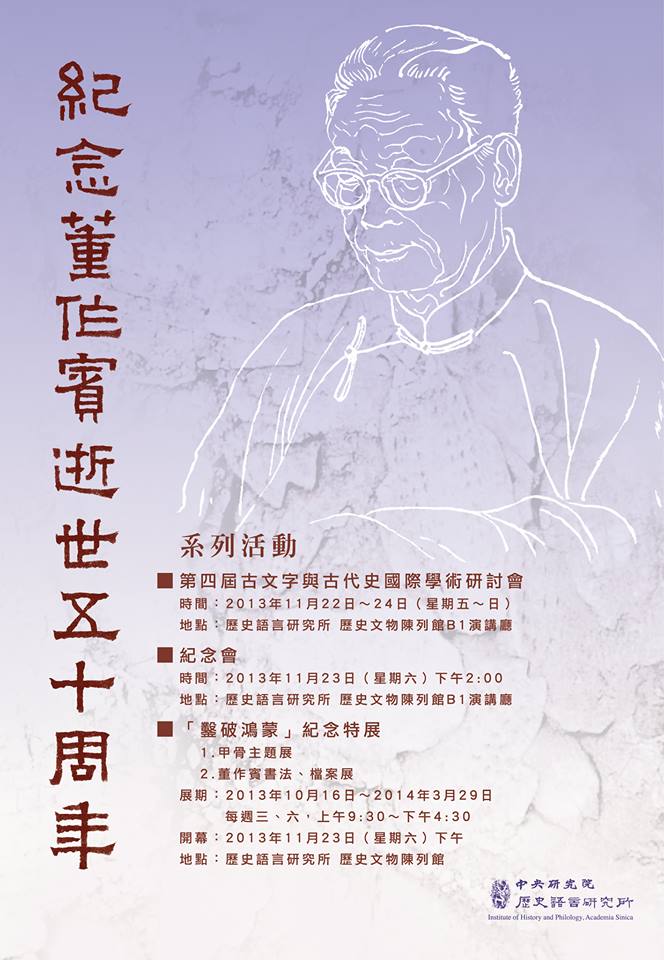
標題:
【展覽】「鑿破鴻蒙」紀念特展
時間:
2013年10月16日至2014年3月29日
地點:
中央研究院史語所文物陳列館(臺北市南港區研究院路二段130號)
主辦單位:
中央研究院史語所
聯絡人:
Tel: (02)27829555
內容簡介:
自2006年開始第一屆古文字與古代史學術研討會的舉辦,往後每兩年舉辦一次,每屆與會者皆超過二百位,是古文字領域重要的學術活動。第四屆將邀請二十餘位國內外古文字或古代史學者專家發表學術論文,進行利用出土古文字材料,研究古代歷史,「古文字」的範疇下及秦漢隸書。
本次會議兼以紀念董作賓先生逝世五十周年,將於11月23日(六)下午2:00舉行「董作賓逝世五十周年紀念會」。另舉辦「鑿破鴻蒙」紀念特展,歡迎踴躍參觀。包含:
1.
2.董作賓書法、檔案展
展期:2013年10月16日至2014年3月29日
每週三、六,上午9:00~下午4:30
開幕時間:2013年11月23日(星期六)下午
地點:歷史語言研究所歷史文物陳列館
系統號:
A-002623
【展覽】永是有情人——琦君捐贈展
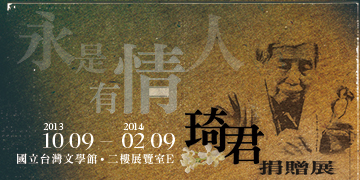
標題:
【展覽】永是有情人——琦君捐贈展
時間:
2013年10月9日至2014年2月9日
地點:
國立臺灣文學館2F展覽室E(臺南市中西區中正路1號)
主辦單位:
國立臺灣文學館
聯絡人:
Tel: (06)221-7201
內容簡介:
琦君(1917~2006),本名潘希珍,以散文享譽文壇,內容書寫臺灣生活、海外見聞、故鄉風情,其中以回憶早年生活的懷舊文章最出色,風格溫柔敦厚,充份展現其待人以寬的人格特質。1998年由九歌出版的《永是有情人》書序中,以〈大媽媽敬祝您在天堂裡生日快樂〉為題,自陳身世:即其筆下的父母親,實際上是她的伯父伯母。琦君1歲喪父、4歲喪母、13歲喪兄,生母臨終前將她託付給伯父伯母,此後成為養育琦君一生最重要的親人。
本展以「永是有情人」為題,除了本書為其自陳真實身世的著作,有其重要轉折意義外,琦君重「情」,這樣的心態多少透露在她的書名中,不只是懷舊之情,琦君旅美、居臺,每到一處,都與當地友人保持深摯淳厚的情感,並化為詩文與信札,字裡行間可見其真性情。
本展除展出琦君歷年著作,其1,400餘本藏書、1,600餘封信札、近7千張相片以及資歷證件正本等,亦於本展逐一呈現,此外,琦君結婚證書、常穿衣物及贈媳的髮簪、剪斷的金戒指亦一併展出,呈現琦君以一女性之姿而成散文巨擘的風采。
本展覽開放時間為週二至週日(週一休館),9:00-21:00。
系統號:
A-002624
【展覽】海上瓷路——粵港澳文物大展
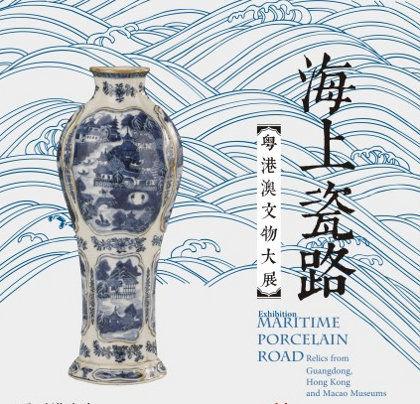
標題:
【展覽】海上瓷路——粵港澳文物大展
時間:
2013年7月19日至2014年2月16日
地點:
香港藝術館中國文物展覽廳(香港九龍尖沙咀梳士巴利道10號)
主辦單位:
廣東省文化廳、澳門特別行政區政府文化局、香港特別行政區政府民政事務局
聯絡人:
E-mail: enquiries@lcsd.gov.hk
內容簡介:
為促進粵港澳地區的文化合作,落實第11次粵港澳文化合作會議的工作計劃,廣東省博物館、澳門博物館及香港藝術館由2012至2014年聯合舉辦「海上瓷路 ─ 粵港澳文物大展」。這個巡迴展覽首站已於2012年5月在澳門舉行,第二站亦於今年5月中旬在廣州完滿結束。最後一站將於2013年7月19日至2014年2月16日假香港藝術館展出。本展覽以外銷瓷作為主線,精選三館一共170多套展品,以探討中國外銷瓷器的重要性及影響力,及講述中國瓷器對東南亞、中東及歐洲等地的重要影響。
本展覽開放時間:
星期一至五上午10時至下午6時
星期六、日及公眾假期上午10時至下午7時
逢星期四(公眾假期除外)休館
聖誕節前夕及農曆年除夕提早於下午5時休館
農曆年初一、二休館
系統號:
A-002625
【展覽】「臺灣農夫‧穿越時空的農業記錄」館藏特展

標題:
【展覽】「臺灣農夫‧穿越時空的農業記錄」館藏特展
時間:
2013年10月15日至2014年4月18日
地點:
國立臺灣歷史博物館展示教育大樓1樓大廳(臺南市安南區長和路一段250號)
主辦單位:
國立臺灣歷史博物館
聯絡人:
Tel: 06-356-8889
內容簡介:
田野裡的農夫,一鋤一鋤地埋首耕耘腳下的大地,粗糙長繭的雙手與額上滴落的汗水,在為一家溫飽掙扎的過程中,同時也孕育出人類文明的基礎。話說「民以食為天」,數千年前,當人類馴服了家畜、跨上了馬背;數百年前成功橫越了大洋;近百年征服了天空,甚至登上了月球,這些從大地緩緩長出的農作物,仍不變地供應著人類最根本、最原始的需求,所以,農是人類一切活動、安定生存的根本。
農業生產與人類活動息息相關,數千年來,人類透過人工控制方式,利用並改造自然環境進行農業生產,進而獲取生存與發展所需的經濟效益,因此,農業生產的豐稔也往往隨著時代的推演與社會變遷而改變,並且左右著農業活動發展的方向與面貌,臺灣傳統農業的開端始於滿足口食的需求,而科學農業的出現,則是致力透過技術、品種改良等方式提高務農生產,來因應人類社會人口與經濟規模擴大、轉型的需要。在這一頁頁農業篇章不斷變動的過程中,讓我們透過臺灣農夫的手與眼,觀看穿越時空的臺灣農業記錄與變遷。
本展覽開放時間為週二至週日上午9時至下午5時(入館時間至下午4時30分)。
休館日:每週一(逢國定假日照常開放,翌日休館)、農曆除夕及年初一、政府公告之天然災害停止上班日、國立臺灣歷史博物館另行公告之必要休館日。
系統號:
A-002626
【展覽】履踪:臺灣原住民文獻圖畫特展
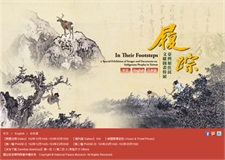
標題:
【展覽】履踪:臺灣原住民文獻圖畫特展
時間:
2013年12月14日至2014年05月19日
地點:
國立故宮博物院104陳列室(臺北市士林區至善路二段221號)
主辦單位:
國立故宮博物院
聯絡人:
Tel: 886-(2)-28812021
內容簡介:
臺灣是一座融匯多元族群、歷史與文化的島嶼,千百年前就已在這塊土地上墾殖衍茂的原住民,更是全島早期歷史舞臺上的重要角色。他們活躍於山林原野之間,擁有獨特的語言、技藝、服飾、樂舞、社會組織以及價值信仰,部分內涵猶且傳續至今,成為臺灣社會多元樣貌中最質樸淳厚的文化標誌。
有清一代,漢人大量移墾臺灣,清朝且是首度開啟與各地原住民頻繁接觸的中央政權。滿族以少數民族之姿入主中原,有關邊疆族裔的政策思維,較中國歷代周延且敏銳,其中亦含括對臺灣原住民的統御規畫。聖祖康熙曾經接見有才藝的原住民,乾隆皇帝也頒賜厚禮贈予前來賀壽的部落頭目。另一方面,清廷也嘗制訂嚴格的封禁政策,阻禁移民數量遽增的漢人任意入山開墾,致力維護原住民的生活畛域,直至同治十三年(1874)「牡丹社事件」後,方始弛禁。國立故宮博物院典藏清朝中央暨閩、臺各級文武要員之奏摺、文集頗豐,不乏關於臺灣原住民活動的珍貴紀錄,可具體反映清朝官方對原住民的傳聞印象、互動經驗、政策理念,是瞭解近三百年臺灣原住民史地履踪的重要文獻。
本次特展以院藏古籍、檔案、輿圖、畫卷與契約文書為主,搭配商借自中央研究院歷史語言研究所、國立臺灣博物館、國立臺灣圖書館、國立臺灣歷史博物館,以及北京故宮博物院的相關圖畫文獻,呈現十八、十九世紀臺灣原住民的多元風貌、清廷對臺灣的族群政策、原漢之間的互動關係,乃至外來過客所留下的圖影寫真,期以透過文物史料的展陳與解說,引領觀眾深入了解臺灣早期的風土環境、部落分布、風俗物產、文教信仰、衝突競爭,以及清季的開放山禁、推廣教育等措施。本院冀望觀眾能以開闊的胸懷覽照古今,諦思當代臺灣原住民獨特的精神文化,讓不同的族群在同一塊土地上互珍互重,協力並進。
本展覽全年開放,8:30-18:30,夜間延長開放時段:每週五、週六18:30-21:00,國人憑身分證件可免費參觀。
系統號:
A-002627
【展覽】定州花瓷--院藏定窯系白瓷特展
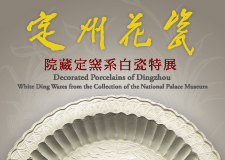
標題:
【展覽】定州花瓷--院藏定窯系白瓷特展
時間:
2013年11月30日至2014年9月30日
地點:
國立故宮博物院第一展覽區203陳列室(臺北市士林區至善路二段221號)
主辦單位:
國立故宮博物院
聯絡人:
Tel: 886-(2)-28812021
內容簡介:
定窯,位在中國古代定州區域所產的瓷器,其白瓷作品為宋代以來所推尊。考古發現其最主要的窯區在今河北省曲陽縣境,窯場綿延密佈,產量豐富。唐代開始興作,十世紀晚唐、五代時成為中國北方名窯,產品廣受中原、江南、遼國貴族所喜愛。及至宋、金時期,定窯窯業技術精進,如以煤為燃料、以覆燒技法改善質量、以劃花與印花裝飾器表,均成就定窯的特殊性。不但為貢入北宋、金朝的內廷用品,也突破邊境藩籬,廣見於大遼與南宋的墓葬中,故享有「天下第一」的讚譽。
北宋蘇東坡曾詠歎「定州花瓷琢紅玉」,金人劉祁亦記載「定州花瓷甌,顏色天下白」句,足見有花紋的定窯白瓷,風靡當時代。白色胎土上或以刀刻劃花紋、或以模子笵印花紋,罩上透明釉後,紋線間積釉色深,呈現清晰的圖案,為牙白素淨的瓷面增添無限的華美。這樣含蓄溫雅、變化萬千的美感,是賞鑒家們心目中的白瓷典範,遂也為宋代以來各地官民窯場競相襲仿。
國立故宮博物院的收藏裡,定窯類型的瓷器近八百件,多數具有花紋,無論劃花流暢如畫、印花繁麗如織繡,均能見到宋人紋樣設計的多樣趣味。本次展覽分兩期,將於五月作局部展品更換,使觀眾共享本院定窯藏品之豐富。
本展覽全年開放,8:30-18:30,夜間延長開放時段:每週五、週六18:30-21:00,國人憑身分證件可免費參觀。
系統號:
A-002628
【展覽】光照大千──絲綢之路的佛教藝術考古特展
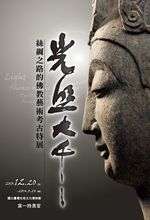
標題:
【展覽】光照大千──絲綢之路的佛教藝術考古特展
時間:
2013年12月20日起至2014年3月20日
地點:
國立臺灣史前文化博物館第一特展室(臺東市博物館路1號)
主辦單位:
中華文物交流協會、沈春池文教基金會、中國文物交流中心、國立臺灣史前文化博物館
聯絡人:
Tel: 089-381166
內容簡介:
源起於印度的佛教信仰,卻穿越兩千五百多年的傳播,深植在亞洲民族的思維中。然而佛教的實質傳播路徑,卻也透過了橫跨歐亞的貿易之路——絲路,將佛教文學與藝術遺留在絲路上的遺址裡。在西方殖民主義侵略下,經過了19世紀各國考古學家的發現與掠奪後,絲路上碩果僅存的文物,在當地文化財產機構的發掘與保護下,跨越新疆、陝西及甘肅三個省份,整合了十六個收藏機構的百來件文物,其中包含19件由中國鑑定的國寶。本館將從宗教信仰與美術考古的角度與您分享,這些遺落在絲路上文物的歷史脈絡與故事。
本展覽開放時間為週二至週日9:00-17:00,每週一休館。
系統號:
A-002629
【展覽】水火交‧天人會:臺灣王爺信仰特展
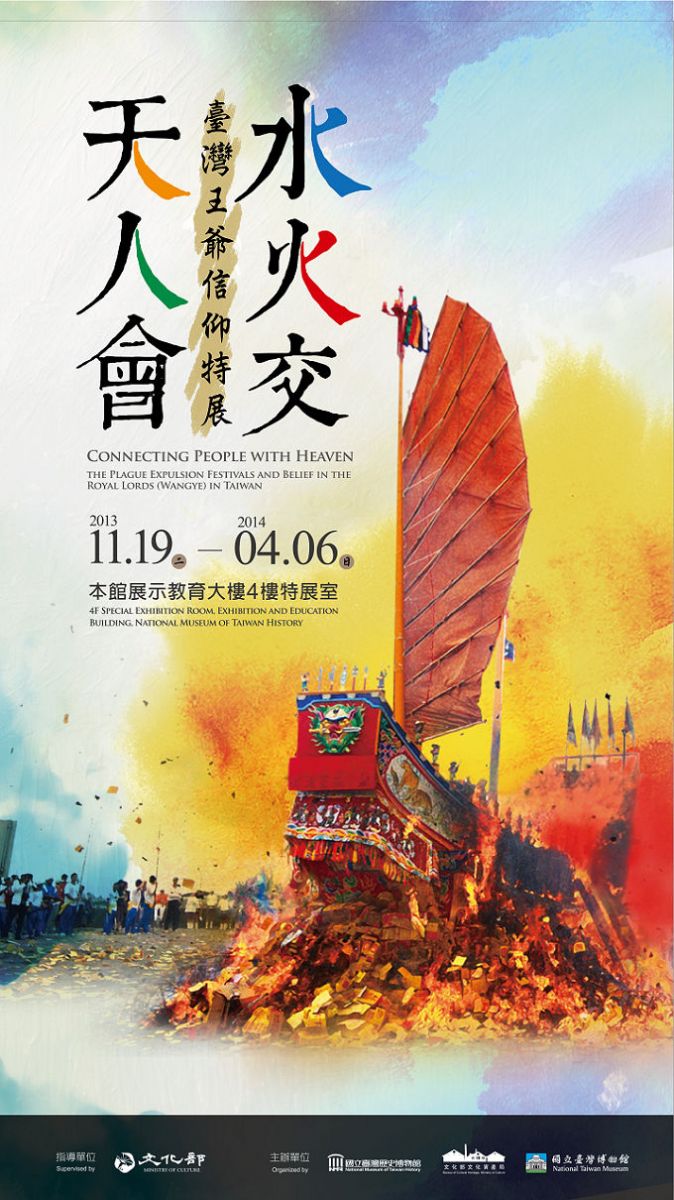
標題:
【展覽】水火交‧天人會:臺灣王爺信仰特展
時間:
2013年11月19日至2014年4月6日
地點:
國立臺灣歷史博物館展示教育大樓4樓特展室(臺南市安南區長和路一段250號)
主辦單位:
國立臺灣歷史博物館
聯絡人:
Tel: (06)3568889#8103
內容簡介:
臺灣四面環海、信仰活動豐富,王爺信仰是極為盛行的民間信仰之一,又以西南沿海各地的「王醮」(又稱「瘟醮」、「迎王祭典」)最具特色。許多地方每年、隔數年或不定期地興造王船、舉辦醮典科儀、遶境刈香、送船火化等豐富的儀式,壯觀的場面、馬拉松式的動員,成為社區團結、地方文化展現、商業觀光的原動力,映照出臺灣社會與海洋文化關係,也反映了歷來人與神、人與人的社會群體關係。
水:迎王祭典的舞臺
水,為王爺信仰、王船祭典打造了重要的舞臺。王爺信仰盛行於臺灣西南沿海與澎湖一帶,往往隨著早期移民攜帶的原鄉香火或漂流王船渡海來臺;因此在各地的王醮、迎王祭典中,人們常自河海邊恭迎王爺上陸,為地方百姓消災解厄、驅瘟逐疫,再送到水邊隨王船火化。
王船的建造與神聖化,是這場以水為舞臺的祭事重要前置準備,更展現了地方文化特色、發揮團結力量。
火:王醮與送王
「火」是天地轉化的動力,也是迎王祭典運作的關鍵力量。各地祭典多以「迎王」儀式作為起始,火化王船的「送王」作為結束,主要精神在於迎接代天巡狩的王爺,協助地方驅瘟逐疫、消災解厄,恪遵古禮服祀王爺的王府,同時舉辦的道教科儀,大規模的遶境活動等等,都在祭典的這幾天內接連不斷、熱烈地展開
天:代天巡狩千歲爺
臺灣人口中的「王爺」、「千歲爺」,是一種統稱,其姓氏、形象、化神傳說各有不相同。這樣的信仰,隨著移民社會的原鄉香火及海外漂來的王船傳入,伴隨各式應驗傳說在臺灣各地落地生根,發展出不同的信仰風貌,也因應社會的變遷、各地風俗產業的不同,發展出豐富多元的樣貌。
人:合境平安的認同與參與
信仰的根本在於「人」,在祭典中人展現的不僅是對神明的崇敬,對社會群體的認同,也是對公眾事務積極投入的熱忱。祭典的核心組織、運作人員,熱烈參與的廟宇陣頭、轎班,為打造王船投入心血的藝師,乃至地方信眾、旅外遊子、親朋好友等,連結起人與神的關係,串連起人與人、人與群體、社會間的聯繫,是祭典綿延發展的動力,更是其感動人心之處。
本展覽開放時間為每週二至週日上午9時至下午5時(入館時間至下午4時30分)。春節期間開館日另有公布,請參見官網(http://www.nmth.gov.tw/)
系統號:
A-002686
【展覽】明四大家特展——沈周

標題:
【展覽】明四大家特展——沈周
時間:
2014年1月10日至3月31日
地點:
國立故宮博物院202、204、206、208、210、212 陳列室(臺北市士林區至善路二段221號)
主辦單位:
國立故宮博物院
聯絡人:
Tel: 886-(2)-28812021
內容簡介:
明代中期江南地區經濟富庶,文藝高度發展,時沈周、文徵明、唐寅、仇英繪畫成就卓越,人稱「明四大家」。本院典藏明四大家書畫作品數量可觀,品質精良,是以於今年策劃一系列特展,將分四期展出,以完整呈現四家藝術發展的面貌。本期以四家之首的沈周為題,精選本院所藏沈周書畫及其師友作品,藉以彰顯沈周的藝術源流與成就。
沈周,字啟南,號石田、白石翁,蘇州府長洲縣相城人,生於明宣德二年(1427),卒於明正德四年(1509),享年八十三歲。家族世居長洲,祖沈孟淵、父沈恒吉、伯父沈貞吉皆未出仕,蒐藏甚豐,以詩文、書畫著稱,並積極參與各項文藝活動。
沈周自幼過目成誦,聰慧絕人。少從陳寬學,既長,廣涉經傳子史百家,兼及醫方卜筮,乃至野史傳奇等。詩文、書畫俱有所成。受家族薰染,亦熱衷於文物鑑賞收藏。其為人敦厚謙和,一生不應科舉,以奉養親族為由,多次辭卻出仕機會,隱居為樂。沈周雖稱隱士,但與蘇州士人往來密切,不僅詩畫唱和,更常結伴出遊,徜徉於蘇州附近湖光美景。往來的師友,如吳寬、王鏊等,都具備深厚的文化素養,富收藏,好品鑑,經常相互交流,並觀覽題詠,這些藝文活動形塑了蘇州吳門畫風重要的文化底蘊。
此特展規劃「沈周的藝術淵源」、「沈周的書法藝術」和「沈周的畫藝特色」三個單元,藉以鉤陳沈周師友文藝與收藏概況、書法成就以及畫藝發展脈絡。其中,〈寫生冊〉筆墨酣暢,乃沈周寫意傑作,是以單獨闢室陳列。此次展出約六十餘組件,概括了沈周藝術的全貌。
本展覽全年開放,8:30-18:30,夜間延長開放時段:每週五、週六18:30-21:00,國人憑身分證件可免費參觀。
系統號:
A-002688
【展覽】高句麗壁畫古墳寫真展

標題:
【展覽】高句麗壁畫古墳寫真展
時間:
2013年6月4日至2014年2月2日
地點:
九州國立博物館4F文化交流展示室南側ギャラリー通路(福岡県太宰府市石阪4-7-2)
主辦單位:
九州國立博物館、共同通信社
聯絡人:
Tel: 092-918-2807
內容簡介:
高句麗とは、現在の中國東北部から朝鮮半島の北・中部にかけた地域に今から1500年ほど前に存在した古代國家です。領土拡張のため、當時は倭と呼ばれていた日本をはじめ、近隣諸國や異民族との間で繰り返し爭う好戦的な面を持つ一方、朝鮮半島諸國の中ではいち早く仏教を受容するなど、高い文化を育んでいました。
そのひとつが、平壌(北朝鮮)や集安(中國吉林省)などの都に築造された壁畫古墳群です。これらは、故平山郁夫畫伯らの盡力によって、2004年に國連教育科學文化機関(ユネスコ)の世界文化遺産に登録されました。
このたび九州國立博物館と共同通信社が「世界遺産:高句麗壁畫古墳寫真展」を開催することになりました。世界遺産登録直後の2004年および2010年、2011年に朝鮮社會科學院考古學研究所とともに合同調査を実施した際、共同通信社が高精彩デジタルカメラで撮影した多數の壁畫をご紹介いたします。荘厳な儀式に臨む王と高官、當時の人々の日常生活-などを精緻に描いた色鮮やかな壁畫の數々に出會うことで、高句麗文化への親近感のみならず、飛鳥や九州の裝飾古墳との類似性や相違點をも感じとっていただければ幸いです。
本展覽開放時間為9:30-17:00,月曜日休館。
系統號:
A-002621
【展覽】Colors of the Universe: Chinese Hardstone Carvings

標題:
【展覽】Colors of the Universe: Chinese Hardstone Carvings
時間:
2013年12月11日至2014年7月6日
地點:
The Metropolitan Museum of Art, Galleries 221(1000 Fifth Avenue. New York, 10028,USA)
主辦單位:
The Metropolitan Museum of Art
聯絡人:
The Metropolitan Museum of Art, Tel: 212-535-7710
內容簡介:
Stone carving is one of the oldest arts in China, its beginnings dating back to remote antiquity. Although jade, the mineral nephrite, was held in the highest esteem, all stones that could achieve a luster after polishing, be it agate, turquoise, malachite, chalcedony, quartz, jasper, or lapis lazuli, were also appreciated. Stone carving experienced an efflorescence during the Qing dynasty (1644–1911), when an abundant supply of raw materials, exceptionally accomplished craftsmen, and, in particular, keen imperial patronage contributed to the creation of numerous superb works.
The stone carvings of the Qing period can be grouped in three categories: personal adornments such as rings, bracelets, and pendants; articles for daily use (mainly in the scholar's studio) such as brush holders, water pots, and seals; and display pieces such as copies of antiques, miniature mountains, and animal and human figures, the latter being the largest of the group. The carvings can also be classified by their decorative style: archaic or classical, meaning their shapes were derived from ancient ritual vessels; "Western," which bore the influence of contemporary Mughal art from northern India; and new or modern, meaning novel shapes and designs created during the Qing dynasty.
A common decorative theme, especially among works of the new style, was the use of rebuses, which are symbols associated with auspicious meanings, to convey wishes for prosperity, longevity, good fortune, perpetuation of a family line, or academic success. The tradition began early but remained largely in the popular culture until the sixteenth and seventeenth centuries, when significant social changes and increased imperial patronage helped elevate the rebus to the high art of the court.
系統號:
A-002619
【展覽】Ink Art: Past as Present in Contemporary China

標題:
【展覽】Ink Art: Past as Present in Contemporary China
時間:
2013年12月11日至2014年4月6日
地點:
The Metropolitan Museum of Art, Galleries 206-220(1000 Fifth Avenue. New York, 10028,USA)
主辦單位:
The Metropolitan Museum of Art
聯絡人:
The Metropolitan Museum of Art, Tel: 212-535-7710
內容簡介:
The first major exhibition of Chinese contemporary art ever mounted by the Metropolitan, Ink Art explores how contemporary works from a non-Western culture may be displayed in an encyclopedic art museum. Presented in the Museum's permanent galleries for Chinese art, the exhibition features artworks that may best be understood as part of the continuum of China's traditional culture. These works may also be appreciated from the perspective of global art, but by examining them through the lens of Chinese historical artistic paradigms, layers of meaning and cultural significance that might otherwise go unnoticed are revealed. Ultimately, both points of view contribute to a more enriched understanding of these artists' creative processes.
For more than two millennia, ink has been the principal medium of painting and calligraphy in China. Since the early twentieth century, however, the primacy of the "ink art" tradition has increasingly been challenged by new media and practices introduced from the West. Ink Art examines the creative output of a selection of Chinese artists from the 1980s to the present who have fundamentally altered inherited Chinese tradition while maintaining an underlying identification with the expressive language of the culture's past.
Featuring some seventy works by thirty-five artists in various media—paintings, calligraphy, photographs, woodblock prints, video, and sculpture—created during the past three decades, the exhibition is organized thematically into four parts: The Written Word, New Landscapes, Abstraction, and Beyond the Brush. Although all of the artists have challenged, subverted, or otherwise transformed their sources through new modes of expression, Ink Art seeks to demonstrate that China's ancient pattern of seeking cultural renewal through the reinterpretation of past models remains a viable creative path.
系統號:
A-002620





